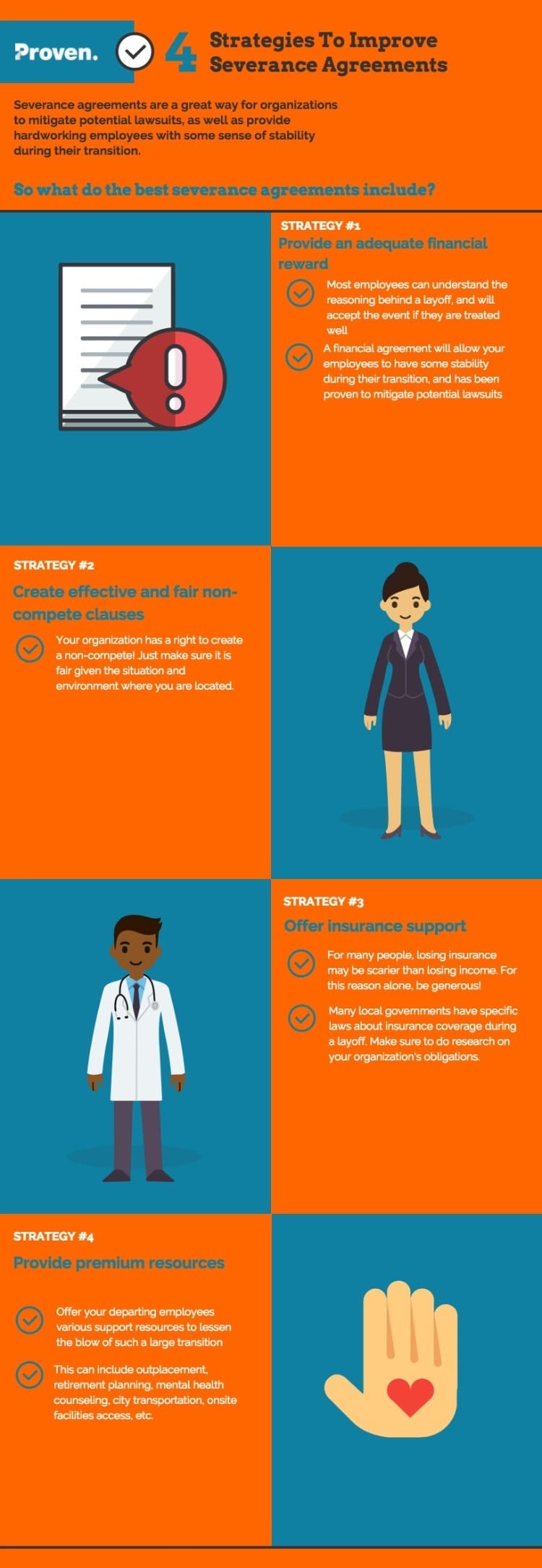A Severance Agreement (In 4 Easy Steps)
July 21, 2014 by Josh Hrala

Request Pricing
Compare our rates to other providers
Layoffs and reductions in force (RIF) are common business practices no matter what economic climate we are in, which means your company needs a surefire strategy when it comes to letting people go. And, the best practice to handle those moments is with an ironclad severance agreement.

What Is a Severance Agreement?
A severance agreement – also known as a “separation agreement” or “severance payment agreement” – is a legal document between you, the employer, and the outgoing employee that details all of the specific terms of the employee’s termination.
Basically, a severance agreement is a waiver or release of liability that the outgoing employee signs, protecting the business from lawsuits. These agreements usually include compensation, outplacement services, and other benefits in exchange for the employee’s signature. You can read more about severance agreements from SHRM.
Your severance agreement should be offered to the employee during the notification meeting by your HR manager who will go over the details of document with the employee. This can be a tricky conversation to have, which is why we suggest you have a layoff script on file. If you already have a script and a severance agreement, you can check out our improvement guide to make sure it covers all of the bases:

Why Is a Severance Agreement so Important?
In short, they protect you when you have to let people go. They also help your employee with the transition by providing them pay and other benefits to get them to their next job.
In the past, businesses have relied on the guidelines of the Equal Employment Opportunity Commission (EEOC) to draft their severance agreement.
After a lawsuit involved CVS back in 2014, the EEOC has taken an aggressive approach to ensuring company’s use a proper severance agreement. This means that if you have been using an older template, it’s time to upgrade to ensure you are compliant to the newer guidelines.
How to Deliver the Severance Agreement to Outgoing Staff
There are four easy-to-follow steps when it comes to delivering the agreement. Following these steps will ensure you cover all of your bases, leaving nothing to chance:
Step One: Provide Time For Consideration
“How long do I have to sign a severance agreement?” is typically the first thing someone Googles after meeting with with their HR manager. This is because signing a severance agreement is a big deal and no one wants to rush and sign something they haven’t fully read.
Employees should be given at least 21 days to review the severance agreement. Make sure you advise the employee to have the severance agreement and general release reviewed by an attorney.
Do not pressure the employee to sign early or rush back to the office, even if you offer the 21 days. An employee’s decision to sign a release must also be voluntary, or courts will not enforce the release. Once signed, you must provide 7 days revocation period to change their mind
Step Two: Provide a List of Competitors for the Non-Compete Agreement
This step depends on whether or not you are going to incorporate a non-compete inside your severance agreement.
If so, it’s helpful to jot down a list of your competitors to make sure this section will hold up in court if it should come to that.
It’s important to point out that this approach isn’t always used and, if you decide to do so, you are telling your employee that they cannot work in the same industry. If someone has dedicated their career to a certain industry, this can ruin the agreement in a heartbeat.
The best advice is to talk with your legal team about whether or not a non-compete is needed or should be implemented.
Step Three: The Release of Waiver
Listen up because this is the most important part of the whole thing. You cannot – repeat, cannot – prohibit your employee from filing a claim with the EEOC.
That means that you should (read: must) have a separate paragraph inside your severance agreement that goes over the rights the employee has, specifically that they can contest their termination by filing a claim. This is an important section to go over with your legal team.
Step Four: Understand the Special Rules
If the outgoing employee is over 40 years old, special things must be included in the severance agreement.
Among other things, you must give these employees a longer period of time to review the severance agreement, allow them to revoke the agreement or change their minds for a limited time after they sign, and advise them in writing to consult with an attorney. Make sure to modify your document for these situations or keep a “severance agreement over 40” file on hand.
To help keep all of these rules on your mind when drafting your document, we made this handy infographic:
More from Careerminds
In need of outplacement assistance?
At Careerminds, we care about people first. That’s why we offer personalized talent management solutions for every level at lower costs, globally.




